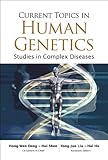Current topics in human genetics : studies in complex diseases / co-editors-in-chief, Hong-Wen Deng, Hui Shen ; associate editors, Yong-Jun Liu, Hai Hu.
Material type: TextPublication details: Hackensack, NJ : World Scientific, ©2007.Description: 1 online resource (xii, 950 pages) : illustrations (some color)Content type:
TextPublication details: Hackensack, NJ : World Scientific, ©2007.Description: 1 online resource (xii, 950 pages) : illustrations (some color)Content type: - text
- computer
- online resource
- 9789812790811
- 9812790810
- 1281938432
- 9781281938435
- 9786611938437
- 6611938435
- Genetic disorders
- Medical genetics
- Genetic Diseases, Inborn -- genetics
- Genetic Predisposition to Disease -- genetics
- Genetics, Medical -- methods
- Genetic Diseases, Inborn
- Genetics, Medical
- Maladies génétiques
- Génétique médicale
- HEALTH & FITNESS -- Diseases -- Genetic
- MEDICAL -- Genetics
- Genetic disorders
- Medical genetics
- 616/.042 22
- RB155.5 .C87 2007eb
- 2008 C-296
- QZ 50
| Item type | Home library | Collection | Call number | Materials specified | Status | Date due | Barcode | |
|---|---|---|---|---|---|---|---|---|
 Electronic-Books
Electronic-Books
|
OPJGU Sonepat- Campus | E-Books EBSCO | Available |
Includes bibliographical references and indexes.
Print version record.
Analogies play a fundamental role in science. To understand how and why, at a given moment, a certain analogy was used, one has to know the specific, historical circumstances under which the new idea was developed. This historical background is never presented in scientific articles and quite rarely in books. For the general reader, the undergraduate or graduate student who learns the subject for the first time, but also for the practitioner who looks for inspiration or who wants to understand what his colleague working in another field does, these historical circumstances can be fascinating and useful. This book discusses a series of analogy effects in subatomic physics, the prediction and theory of which the author has contributed to in the last 50 years. These phenomena are presented at a level accessible to the non-specialist, without formulae but with emphasis on the personal and historical background: memoirs of meetings, discussions and correspondence with collaborators and colleagues. As such, besides its scientific aspects, the book constitutes an absorbing witness account of a holocaust survivor who subsequently illegally crossed the Iron Curtain to escape communist persecution.
Preface; Acknowledgments; 1 Regression-based Linkage Analysis Methods Tao Wang and Robert C. Elston; 1. INTRODUCTION; 2. THE NUMBER (PROPORTION) OF ALLELES SHARED IBD; 3. VARIOUS REGRESSION-BASED METHODS WITH DIFFERENT TRAIT SIMILARITY MEASURES; 3.1. The Original Haseman-Elston Regression; 3.2. New Regression-based Methods; 3.3. Regression-based Linkage Methods for Any Type of Pedigree Structure; 4. DISCUSSION; ACKNOWLEDGMENTS; REFERENCES; 2 Admixture Mapping: Methods and Applications Xiaofeng Zhu; 1. INTRODUCTION; 2. ADMIXTURE MAPPING; 3. HIDDEN MARKOV MODEL
4. EM ALGORITHM FOR ESTIMATING ANCESTRY5. MARKOV CHAIN MONTE CARLO (MCMC) APPROACH; 6. INFORMATIVE MARKERS FOR ANCESTRY; 7. POWER OF ADMIXTURE MAPPING; 8. APPLICATION; 9. LIMITATIONS; 10. CONCLUSIONS; ACKNOWLEDGMENT; REFERENCES; 3 Survival Analysis Methods in Genetic Epidemiology Hongzhe Li; 1. INTRODUCTION; 2. SURVIVAL ANALYSIS METHODS FOR AGGREGATION ANALYSIS; 2.1. Shared Frailty Models Based on Random Sample of Families; 2.2. Multivariate Frailty Models; 2.3. Familiar Aggregation Based on Case-Control Family Design; 3. SURVIVAL ANALYSIS METHODS FOR SEGREGATION ANALYSIS
3.1. The Cox Gene Model for Gene Segregation3.2. Cox Model with Major Gene and Random Environmental Effects for Age of Onset; 4. SURVIVAL ANALYSIS METHODS FOR LINKAGE ANALYSIS; 4.1. Construction of Genetic Frailties for Sibship; 5. SURVIVAL ANALYSIS METHODS FOR FAMILY-BASED GENETIC ASSOCIATION ANALYSIS; 5.1. Survival Analysis Methods for Family-based Association Tests; 5.2. Test of Genetic Association in the Presence of Linkage; 6. SURVIVAL MODELS FOR HAPLOTYPE EFFECTS BASED ON COHORT, CASE-COHORT, AND NESTED CASE-CONTROL DESIGNS
6.1. Survival Model for Haplotype Inference Based on Cohort Data6.2. Test of Haplotype Association for Case-Cohort and Nested Case-Control Designs; 7. SURVIVAL ANALYSIS METHODS FOR GENE CHARACTERIZATION; 8. ASCERTAINMENT CORRECTION; 9. SURVIVAL ANALYSIS METHODS IN THE GENOMICS ERA; 10. CONCLUSION AND FUTURE DIRECTIONS; ACKNOWLEDGMENTS; REFERENCES; 4 Genetic Association Studies: Concepts and Applications Jun Li; 1. INTRODUCTION; 2. BASIC METHODS AND COMMON APPLICATIONS; 2.1. Basic Analysis Methods; 2.2. Common Applications; 2.2.1. Candidate Gene Studies; 2.2.2. LD-based Gene Mapping
2.2.3. Characterizing Established Disease Genes3. GENERAL DESIGNS; 3.1. Population-based Controls; 3.1.1. Cohort-Control Design; 3.1.2. Case-Control Design; 3.2. Family-based Studies: Family Member Controls and the Transmission/Disequilibrium Test; 4. GENOMIC CONTROL AND STRUCTURED ASSOCIATION; 4.1. Genomic Control; 4.2. Structured Association; 5. PRACTICAL CONSIDERATIONS IN WHOLE-GENOME STUDIES; 5.1. Power and Sample Size; 5.2. Allelic Heterogeneity; 5.3. Common versus Rare Variants; 5.4. Multiple Testing Corrections; 5.5. Uncertainties in Phenotyping; 5.6. Future Outlook; ACKNOWLEDGMENTS
English.
eBooks on EBSCOhost EBSCO eBook Subscription Academic Collection - Worldwide
There are no comments on this title.

